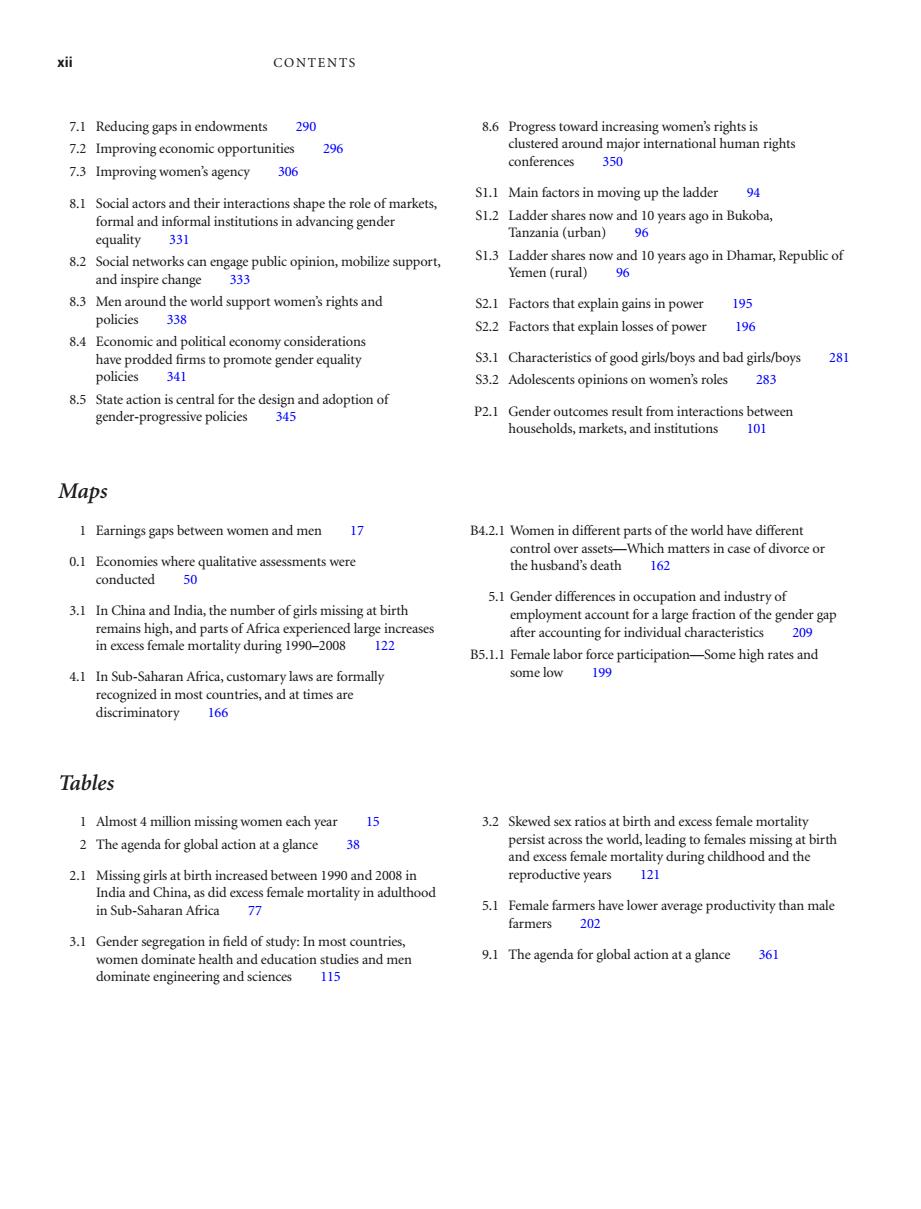正在加载图片...

xii CONTENTS 7.1 Reducing gaps in endowments 290 8.6 Progress toward increasing women's rights is 7.2 Improving economic opportunities 296 clustered around major international human rights conferences 350 7.3 Improving women's agency 306 S1.1 Main factors in moving up the ladder 94 8.1 Social actors and their interactions shape the role of markets, formal and informal institutions in advancing gender S1.2 Ladder shares now and 10 years ago in Bukoba, equality 331 Tanzania (urban)96 8.2 Social networks can engage public opinion,mobilize support, S1.3 Ladder shares now and 10 years ago in Dhamar,Republic of and inspire change 333 Yemen(rural)96 8.3 Men around the world support women's rights and S2.1 Factors that explain gains in power 195 policies 338 S2.2 Factors that explain losses of power 196 8.4 Economic and political economy considerations have prodded firms to promote gender equality S3.1 Characteristics of good girls/boys and bad girls/boys 281 policies 341 S3.2 Adolescents opinions on women's roles 283 8.5 State action is central for the design and adoption of gender-progressive policies 345 P2.1 Gender outcomes result from interactions between households,markets,and institutions 101 Maps 1 Earnings gaps between women and men 17 B4.2.1 Women in different parts of the world have different control over assets-Which matters in case of divorce or 0.1 Economies where qualitative assessments were the husband's death 162 conducted 50 5.1 Gender differences in occupation and industry of 3.1 In China and India,the number of girls missing at birth employment account for a large fraction of the gender gap remains high,and parts of Africa experienced large increases after accounting for individual characteristics 209 in excess female mortality during 1990-2008 122 B5.1.1 Female labor force participation-Some high rates and 4.1 In Sub-Saharan Africa,customary laws are formally some low 199 recognized in most countries,and at times are discriminatory 166 Tables 1 Almost 4 million missing women each year 15 3.2 Skewed sex ratios at birth and excess female mortality 2 The agenda for global action at a glance 38 persist across the world,leading to females missing at birth and excess female mortality during childhood and the 2.1 Missing girls at birth increased between 1990 and 2008 in reproductive years 121 India and China,as did excess female mortality in adulthood in Sub-Saharan Africa 77 5.1 Female farmers have lower average productivity than male farmers 202 3.1 Gender segregation in field of study:In most countries, women dominate health and education studies and men 9.1 The agenda for global action at a glance 361 dominate engineering and sciences 115xii CONTENTS Tables 1 Almost 4 million missing women each year 15 2 The agenda for global action at a glance 38 2.1 Missing girls at birth increased between 1990 and 2008 in India and China, as did excess female mortality in adulthood in Sub-Saharan Africa 77 3.1 Gender segregation in fi eld of study: In most countries, women dominate health and education studies and men dominate engineering and sciences 115 3.2 Skewed sex ratios at birth and excess female mortality persist across the world, leading to females missing at birth and excess female mortality during childhood and the reproductive years 121 5.1 Female farmers have lower average productivity than male farmers 202 9.1 The agenda for global action at a glance 361 Maps 1 Earnings gaps between women and men 17 0.1 Economies where qualitative assessments were conducted 50 3.1 In China and India, the number of girls missing at birth remains high, and parts of Africa experienced large increases in excess female mortality during 1990–2008 122 4.1 In Sub-Saharan Africa, customary laws are formally recognized in most countries, and at times are discriminatory 166 B4.2.1 Women in different parts of the world have different control over assets—Which matters in case of divorce or the husband’s death 162 5.1 Gender differences in occupation and industry of employment account for a large fraction of the gender gap after accounting for individual characteristics 209 B5.1.1 Female labor force participation —Some high rates and some low 199 7.1 Reducing gaps in endowments 290 7.2 Improving economic opportunities 296 7.3 Improving women’s agency 306 8.1 Social actors and their interactions shape the role of markets, formal and informal institutions in advancing gender equality 331 8.2 Social networks can engage public opinion, mobilize support, and inspire change 333 8.3 Men around the world support women’s rights and policies 338 8.4 Economic and political economy considerations have prodded fi rms to promote gender equality policies 341 8.5 State action is central for the design and adoption of gender-progressive policies 345 8.6 Progress toward increasing women’s rights is clustered around major international human rights conferences 350 S1.1 Main factors in moving up the ladder 94 S1.2 Ladder shares now and 10 years ago in Bukoba, Tanzania (urban) 96 S1.3 Ladder shares now and 10 years ago in Dhamar, Republic of Yemen (rural) 96 S2.1 Factors that explain gains in power 195 S2.2 Factors that explain losses of power 196 S3.1 Characteristics of good girls/boys and bad girls/boys 281 S3.2 Adolescents opinions on women’s roles 283 P2.1 Gender outcomes result from interactions between households, markets, and institutions 101